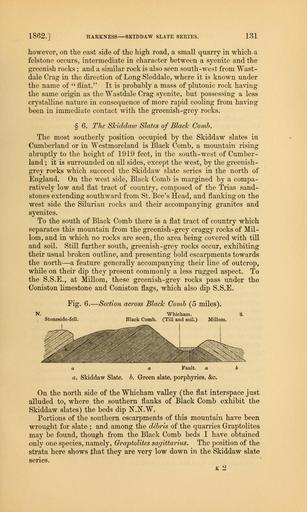MAKE A MEME
View Large Image

| View Original: | The_Quarterly_journal_of_the_Geological_Society_of_London_(12645828023).jpg (1225x2046) | |||
| Download: | Original | Medium | Small | Thumb |
| Courtesy of: | commons.wikimedia.org | More Like This | ||
| Keywords: The Quarterly journal of the Geological Society of London (12645828023).jpg 1862 HARKNESS SKIDDAW SLATE SERIES 131 <br> however on the east side of the high road a small quarry in which a <br> felstone occurs intermediate in character between a syenite and the <br> greenish rocks ; and a similar rock is also seen south-west from Wast- <br> dale Crag in the direction of Long Sleddale where it is known under <br> the name of flint It is probably a mass of plutonic rock having <br> the same origin as the Wastdale Crag syenite but possessing a less <br> crystalline nature in consequence of more rapid cooling from having <br> been in immediate contact with the greenish-grey rocks <br> § 6 The Skiddaw Slates of Black Comb <br> The most southerly position occupied by the Skiddaw slates in <br> Cumberland or in Westmoreland is Black Comb a mountain rising <br> abruptly to the height of 1919 feet in the south-west of Cumber- <br> land ; it is surrounded on all sides except the west by the greenish- <br> grey rocks which succeed the Skiddaw slate series in the north of <br> England On the west side Black Comb is margined by a compa- <br> ratively low and flat tract of country composed of the Trias sand- <br> stones extending southward from St Bee's Head and flanking on the <br> west side the Silurian rocks and their accompanying granites and <br> syenites <br> To the south of Black Comb there is a flat tract of country which <br> separates this mountain from the greenish-grey craggy rocks of Mil- <br> lom and in which no rocks are seen the area being covered with till <br> and soil Still further south greenish -grey rocks occur exhibiting <br> their usual broken outline and presenting bold escarpments towards <br> the north ” a feature generally accompanying their line of outcrop <br> while on their dip they present commonly a less rugged aspect To <br> the S S E at Millom these greenish-grey rocks pass under the <br> Coniston limestone and Coniston flags which also dip S S E <br> Fig 6 ” Section across Black Comb 5 miles <br> N Whicham S <br> Stoneside-fell Black Comb Till and soil Millom <br> a a Fault a b <br> a Skiddaw Slate b Green slate porphyries c <br> On the north side of the Whicham valley the flat interspace just <br> alluded to where the southern flanks of Black Comb exhibit the <br> Skiddaw slates the beds dip N N W <br> Portions of the southern escarpments of this mountain have been <br> wrought for slate ; and among the debris of the quarries Graptolites <br> may be found though from the Black Comb beds I have obtained <br> only one species namely Gh~aptolites Sagittarius The position of the <br> strata here shows that they are very low down in the Skiddaw slate <br> series <br> k 2 35328090 109632 51125 Page 131 Text v 19 http //www biodiversitylibrary org/page/35328090 1863 Geological Society of London NameFound Graptolites NameConfirmed Graptolites NameBankID 423327 NameFound Sagittarius NameConfirmed Sagittarius EOLID 104370 NameBankID 2473453 Biodiversity Heritage Library The Quarterly journal of the Geological Society of London v 19 1863 Geology Periodicals Smithsonian Libraries bhl page 35328090 dc identifier http //biodiversitylibrary org/page/35328090 smithsonian libraries Information field Flickr posted date ISOdate 2014-02-20 Check categories 2015 August 26 CC-BY-2 0 BioDivLibrary https //flickr com/photos/61021753 N02/12645828023 2015-08-27 12 00 29 cc-by-2 0 PD-old-70-1923 The Quarterly journal of the Geological Society of London 1863 Photos uploaded from Flickr by Fæ using a script | ||||